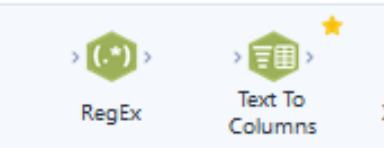Cleansing Data
In Alteryx, regular expressions (RegEx) and the Data Cleansing tool are both tools that can be used to clean and transform data. So if you are wanting to do this you may wonder why to use one tool over another, here are some key differences between the two:
- RegEx can be used for a wide range of tasks, including pattern matching, data cleansing, and data transformation. The Data Cleansing tool, on the other hand, is specifically designed for data cleansing tasks, such as standardizing, de-duplicating, and validating data.
- RegEx uses a specific syntax to define patterns and perform actions on them. This syntax can be complex and require some learning to use effectively. The Data Cleansing tool, on the other hand, has a more user-friendly interface that allows users to select from a list of pre-defined cleansing actions.
- RegEx is generally more flexible than the Data Cleansing tool, as it allows users to define their own patterns and actions. The Data Cleansing tool, on the other hand, is limited to the pre-defined actions that are available in the tool.
Ultimately, whether you should use RegEx or the Data Cleansing tool in Alteryx depends on your specific needs and the complexity of the data cleansing tasks you are trying to perform. In some cases, RegEx may be the better choice due to its flexibility and power, while in other cases, the Data Cleansing tool may be more appropriate due to its ease of use and predefined actions. A good general rule would be that if the task is possible within the Data Cleansing Tool then you should use that as it will likely be faster and easier, but for more complex cleansing you will need RegEx.
Splitting Columns

The Text to Columns tool and regular expressions (RegEx) are both tools that can be used to split a single field into multiple fields. Although both are capable of the same thing, deciding when to use one over the other can be confusing, here are some of the main differences between the two:
- RegEx uses a specific syntax to define patterns and perform actions on them. This syntax can be complex and require some learning to use effectively. The Text to Columns tool, on the other hand, does not require any special syntax and can be used simply by selecting the delimiter that separates the values in the input field. So if you have a simple delimiter then the TTC tool will do.
- RegEx is generally more flexible than the Text to Columns tool, as it allows users to define their own patterns and actions. The Text to Columns tool, on the other hand, is limited to splitting fields based on a single delimiter.
- The Text to Columns tool produces a fixed number of output fields based on the delimiter used, while RegEx can produce any number of output fields based on the patterns defined in the expression. This is very important when dealing with data that needs a lot of cleaning and not just a simple split.
In some cases, the Text to Columns tool may be the better choice due to its simplicity and ease of use, while in other cases, RegEx may be more appropriate due to its flexibility. Similar to before, if the task you are trying to complete is doable with a Text to Columns tool then you should use that, but for occasions where you need it, use RegEx.
